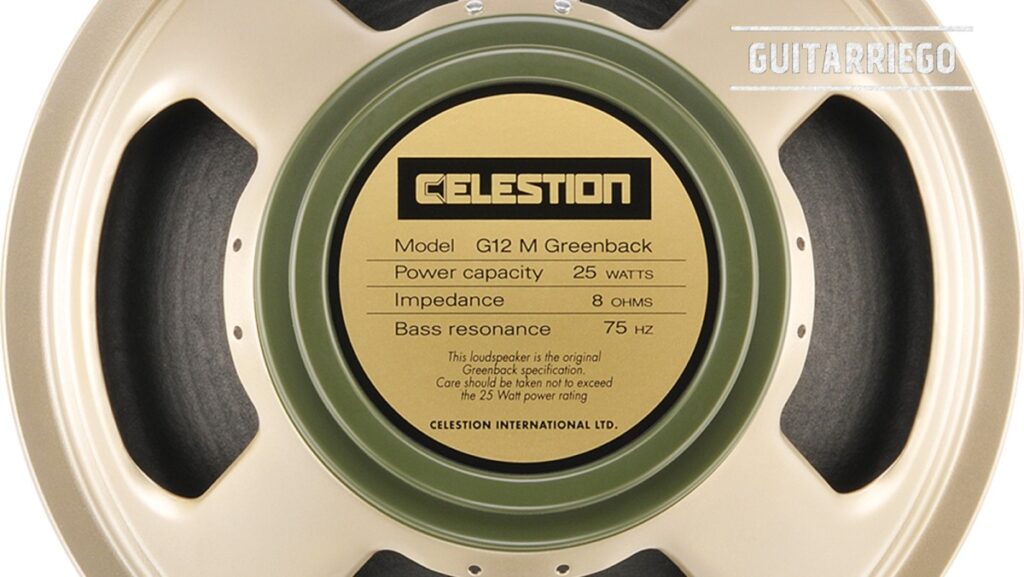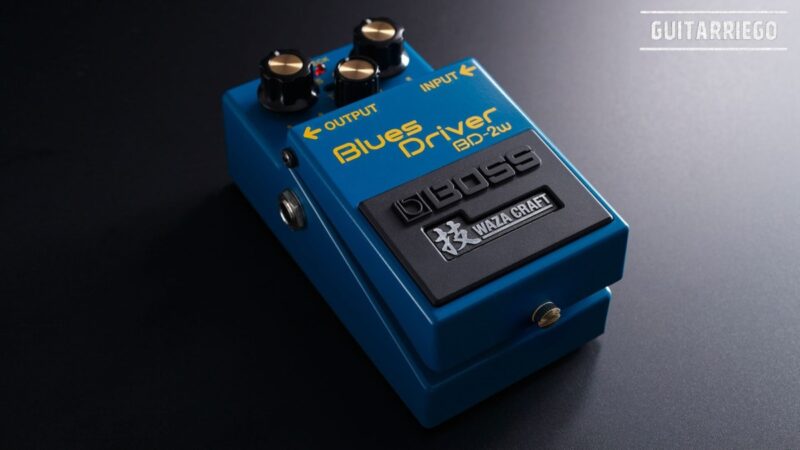Celestion Greenback: The Most Iconic Speakers in Rock History

The Celestion Greenback is the most iconic guitar speaker, crucial for the shaping of Marshall tone and the Sound of Rock in the ’60s and ’70s: its Versions, Sound, Specs and Pros & Cons.
The Iconic Celestion Greenback Speaker
Few components have played as crucial a role in shaping Rock’s iconic sound as the Celestion Greenback speakers inside guitar amplifiers. The legendary Celestion Greenback speakers stand out as part of the Rock sound, for musicians and collectors alike. In this article, we delve into the fascinating history of Celestion Greenbacks and their pivotal role in rock music. From the early days of Celestion to their collaboration with Marshall amplifiers, the Greenback’s journey is nothing short of legendary. Also, we will see its main tonal characteristics, its specifications and its pros and cons.
Celestion Company Profile
Before we dive into the Celestion Greenback’s story, let’s take a quick trip back to the origins of the Company. Celestion, established in 1924, is a venerable name in the world of guitar speakers, especially among British players. What started as a radio speaker manufacturer evolved into a significant player in the music industry, collaborating with legendary artists like Jimi Hendrix, Eric Clapton, and Slash to create signature speaker models capturing their unique tonal characteristics.
Celestion’s influence on rock, blues, and metal is undeniable, from the groundbreaking Celestion Blue alnico speaker in the 1950s to pioneering advancements in magnet materials and cone technologies.

Early Collaborations with Marshall
In the early 1960s, as Jim Marshall and Ken Bran were embarking on their journey to create guitar amps, they encountered challenges in sourcing suitable speakers. Importing heavy 12-inch speakers to post-war Britain was impractical and costly. Fortunately, they turned to a local brand, Celestion, which had already been producing guitar speakers, including the legendary Alnico Blue, the first Celestion speaker for guitar amps.
You might be interested in our guide about how to choose the perfect loudspeaker for your guitar amp.
The Emergence of the Celestion Greenback
During the mid-1960s, speaker manufacturers began experimenting with ceramic-magnet speakers, a more cost-effective alternative to the pricey Alnico magnets. Ceramic magnets had the advantage of producing a slightly more aggressive tone, perfect for the emerging overdriven guitar tones of the ’60s. Celestion introduced its first ceramic-magnet speaker, the T1134, in late 1964.
Marshall, ever the pioneer, adopted these new speakers around late 1965, specifically the T1221, which would go on to be famously known as ‘the Greenback’ due to its distinctive green plastic magnet cover. This marked the beginning of an iconic partnership between Celestion and Marshall.
The Evolution of the Greenback and its versions
As the ’50s and ’60s saw the rise of more powerful amplifiers, the demand for equally robust speakers grew. Marshall addressed this issue by introducing the 4×12 cabinet, though the initial Celestion Greenbacks were rated at only 20 watts, resulting in an 80-watt cab.
The G12M, originally labeled as the T1221 in its 16-ohm version, was initially rated at 20 watts. It became the standard speaker in most Marshall cabinets from around 1966 onwards, whether it was the 1×12 mini-bluesbreaker 18-watt combo, the 2×12 “Bluesbreaker” combo, or the 4×12 stack lead guitar cabinets. The G12M, with its ceramic magnet and responsive cone, offered ample midrange crunch and pleasant low-end compression when pushed. It had a unique character compared to the Alnico speakers used in other amplifiers, providing a fuller-bodied tone with good clarity.
Also, you might be interested in our article on the style and tone of Angus Young.
The Greenback G12H -heavy magnet version-
However, the introduction of the G12H (often referred to as the “heavy magnet” version) in late 1966 brought a solution. This new 12-inch Guitar speaker with a Heavy magnet not only handled more power but was also significantly more efficient. When comparing a cabinet equipped with either G12M or G12H loudspeakers, you’d instantly notice that the G12H was considerably louder. While the G12M had a sensitivity rating of 96 dB, the G12H boasted a full 100 dB sensitivity, which is approximately the difference in volume level between a 100-watt and a 50-watt amp at full power.
One variant of the G12H, the T1281, found its place in Marshall’s high-power 4x12s. The lower bass resonance and higher sensitivity of the G12H made it ideal for both guitar and bass. It’s worth noting that the 75Hz cone version (T1217) was more prevalent in the 1970s, but it’s the T1281 that remains in the hearts of many guitarists for its warm lower mids.

The Celestion G12M is increased to 25 watts
Around late 1968, the Greenback G12M’s power handling capability increased to 25 watts, and it remained at this rating.
The subsequent changes to the Celestion Greenback
The ’70s brought several changes to the Celestion Greenback, including variations in plastic magnet cover colors. However, the most significant change was the shift from Pulsonic cones to slightly more aggressive-sounding Kurt Mueller cones following a fire at the Pulsonic factory in 1973.
The ’80s ushered in new speakers, such as Celestion’s Vintage 30 and G12T-75, both of which achieved massive popularity. Despite these changes, the legacy of guitar speakers, particularly the Greenbacks, remained an integral part of the iconic Marshall cab.
Don’t miss our guide of the most iconic guitar amps ever of all time.
Tonal characteristic of the Celestion Greenback G12M and G12H
Celestion Greenback G12M 20-watt
The first version of the Celestion Greenback is replicated by the current G12M Heritage. This version has 20-watt power rating, 8-ohm, and 15-ohm options, and it maintains the original’s midrange smoothness and crunch. When paired with a vintage Marshall Super Lead and a Les Paul, it delivers a glorious sound characterized by a smooth midrange and crunch. When pushed, it achieves the famous Greenback bottom-end compression. While it sweetens the highs slightly, the sound remains articulate and not dull, making it an excellent choice for classic rock and blues guitarists. The G12M’s compression and dynamic response make it an extension of your tube amplifier.
Celestion Greenback G12M 25-watt
Although there is no reissue of this one, the standard Greenback produced nowadays have the same specs. The Greenback G12M, with its 25-watt power rating and 8-ohm and 16-ohm options, offers a slightly enhanced upper midrange and top end, providing more definition and clarity while retaining the classic Greenback character.

Celestion Greenback G12H
The Greenback G12H is replicated by the G12H Heritage, with its 30-watt power rating and 8-ohm and 15-ohm options, is a different beast altogether. It offers a faster response and a more neutral tone palette, with an emphasis on the high end. The G12H doesn’t compress like the G12M, retaining a solid and unwavering feel. It’s particularly suited for harder rock and metal styles and proves to be a louder speaker compared to the G12M. When paired with a vintage plexi Marshall Super Bass, the G12H shines, producing a big sound with a wide frequency range.
Celestion Greenback G12M vs. G12H Heritage
Tonal characteristics set the G12H apart from the G12M. The G12M compressed richly and had a creamy midrange, whereas the G12H offered a flatter response without emphasizing specific frequencies. It also had more available high-end. The G12H maintained a stiffer feel, making it ideal for bass instruments, although it found favor with rock and metal guitarists as well, most notably Jimi Hendrix.
Celestion Greenback G12M vs. G12M Heritage
The G12M offers a classic British rock tone with a slightly enhanced upper midrange and top end, providing more definition and clarity while maintaining the classic Greenback character. On the other hand, the G12M Heritage aims to replicate the warm, smooth midrange and slightly rolled-off high end of vintage Marshall amps, delivering a more vintage character with a truer creamy breakup and a distinctive growl when pushed.
Also, take a look at our selection of the top free virtual guitar amp simulators your computer.
Specifications of the Celestion Greenback versions
Specifications of the Celestion Greenback G12M
- Size: 12-Inch
- Power Handling: 25 Watts
- Impedance: 8 Ohms or 16 Ohms
- Sensitivity: 98 dB
- Frequency Range: 75 Hz – 5 kHz
- Voice Coil Diameter: 1.75″
- Magnet Type: Ceramic
- Weight: 7.92 pounds
- Warranty: 3 Years
Specs of the Celestion Greenback G12M Heritage
- Nominal Diameter: 12″
- Power Rating: 20W
- Nominal Impedance: 8Ω and 15Ω
- Sensitivity: 96dB
- Voice Coil Diameter: 1.75″, 44.5mm
- Magnet Type: Ceramic
- Frequency Range: 75-5000Hz
- Resonance Frequency (Fs): 86.9Hz
Specifications of the Celestion Greenback G12H Heritage
- Nominal Diameter: 12″
- Power Rating: 30W
- Nominal Impedance: 8Ω and 15Ω
- Sensitivity: 100dB
- Voice Coil Diameter: 1.75″, 44.5mm
- Magnet Type: Ceramic
- Frequency Range: 55-5000Hz
- Resonance Frequency (Fs): 78.9Hz
Understanding “Rola” and “Pre-Rola” Greenback speakers
Among Celestion Greenback enthusiasts and collectors, the terms “Rola” and “Pre-Rola” are often used to distinguish Greenbacks produced at specific times in specific factories. The labels on the green magnet covers provide the key to this distinction. Pre-Rola Greenbacks, produced between 1966 (or even 1964-1965 for those without covers) and April 1971, featured labels indicating production at “Thames Ditton Surrey” and bore the name “Celestion Ltd.” The “Rola” labels, introduced in April 1971, indicated “Ipswich Suffolk” as the production factory and displayed the full company name as “Rola Celestion Ltd” like the one in the photo below.

Also, we recommend that you visit our guide on how to improve your guitar amp tone.
What is the Celestion Greenback sound?
As we already saw the Celestion Greenback is known for its signature Celestion mid-range, detailed with a slightly muted and rolled-off top end while retaining plenty of snap and bark without becoming too fizzy.
With the clean sound, the Greenback feels like home. It offers a balanced sound with a focus on mid-frequencies, making it an excellent foundation for building your sound. Whether you add delay, reverb, or a touch of boost, this speaker delivers.
For many, the Celestion Greenback embodies that classic Marshall-driven sound, especially when paired with a Gibson guitar. That’s the classic Celestion Greenback voice, known for its clarity, perfect for players like Angus Young with a Marshall and a Gibson with humbuckers. It’s particularly favored in classic rock and stoner rock genres.
The Celestion Greenback’s slightly reduced low-end and rolled-off top-end work brilliantly with fuzz pedals. The result is a weighty and heavy sound, making it a popular choice in styles that require this sonic character.
Take a look to this article about the differences between gain vs volume, and how do they work.
Pros & Cons of the Celestion Greenback G12M
Pros of the Greenback G12M
- Vintage British Tone
- Articulate Midrange
- Dynamic Response
Cons of the Greenback G12M
- Power Handling Limitation (25-watt and 20-watt versions)
- High Frequency Roll-off
- Low efficency with Sensitivity 98 dB and 96 dB
Pros & Cons of the Celestion Greenback G12H
Pros of the Greenback G12H
- Vintage British Tone
- Faster response
- Neutral tone palette
- Louder thanks to its sensivity of 100 db
Cons of the Greenback G12H
- Power Handling Limitation with 20 watts
- Non-Aggressive Tone
- The mid-range does not stand out as in the G12M version
In the following video you can see the result of using a vintage Greenback speaker with the cheapest Epiphone solid state amp. You will find that it sounds really good!
Who Is The Celestion Greenback Speaker For?
The Celestion Greenback is an excellent choice for guitarists seeking a classic rock, metal, or blues tone of the rock bands of the ’70s and ’60s. It delivers a warm, balanced, and dynamic sound with an accentuated midrange and touch-sensitive response. This speaker strikes a balance between punchy lows, detailed mids, and smooth highs, cutting through the mix with ease.
For guitarists familiar with the originals or those in search of an alternative to scarce vintage versions, the Celestion Heritage Series G12M and G12H models come highly recommended. They retain the magic of the classic Greenback sound while offering reliability and availability for modern players. Whether you’re seeking the smooth midrange and crunch of the G12M or the faster response and neutral tone palette of the G12H, these reissues deliver what you’re looking for.
Any of these options are ideal for musicians aiming to recreate the sounds of iconic guitarists from the past, such as Jimi Hendrix, and capture the vintage character of rock music from the ’60s and ’70s.
There are other very good Celestion loudspeakers but with different characters as the Vintage 30, the V-Type and the Seventy 80, among others.
Key Takeaways of the Celestion Greenback G12M and G12H
Let’s summarize the key takeaways of the Celestion Greenback G12M and G12H:
- There are several variations of the Greenback: the most popular are the G12M, the G12M Heritage and the G12H Heritage.
- The Celestion G12M Greenback in its standard version is a 12-inch guitar speaker with a power handling capacity of 25 Watts, 98 db of Sensitivity, available in 8 and 16 Ohm impedance models.
- The Celestion G12M Heritage Greenback is a 12-inch guitar speaker with a power handling capacity of 20 Watts, 96 db of Sensitivity, available in 8 and 15 Ohm impedance models.
- The Celestion G12H Heritage Greenback is a 12-inch guitar speaker with a power handling capacity of 30 Watts, 100 db of Sensitivity, available in 8 and 15 Ohm impedance models.
- Each of them delivers a classic British sound that’s perfect for vintage-inspired rock and blues.
- The G12M offers a slightly enhanced upper midrange and top end, providing more definition and clarity while retaining the classic Greenback character.
- The G12M Heritage aims to replicate the vintage sound of the original Greenback with a truer creamy breakup and a distinctive growl when pushed. The Heritage version has a power rating of 20 watts.
- Celestion Greenback G12H Heritage offers a faster response and a more neutral tone palette, with an emphasis on the high end.
- Choosing between the G12M, the G12M Heritage and the G12H Heritage depends on personal preference, your guitar amp and the specific sound you’re aiming for.
Celestion Greenback Legacy
The Celestion Greenback, with its rich history and distinctive sound, has left an indelible mark on the world of rock music. From its early collaborations with Marshall amplifiers to its role in shaping the iconic tones of guitar legends like Jimi Hendrix, the Greenback remains a cherished component of the rock ‘n’ roll legacy.
As the decades have rolled by, Greenbacks have evolved, each era leaving its unique imprint on their design and tonal characteristics. Yet, their enduring appeal continues to captivate musicians, collectors, and enthusiasts alike, making them an everlasting symbol of rock and roll history.
In conclusion, the Celestion Greenback G12M, G12M Heritage and G12H Heritage speakers offer the quintessential British rock and metal sound. Whether you’re chasing the tones of legends like Jimi Hendrix, Jimmy Page, Angus Young or Ritchie Blackmore or seeking to capture that vintage vibe, the Greenback delivers.
You may need a louder speaker, so visit our guide of the Loudest 12″ Guitar Loudspeakers.






